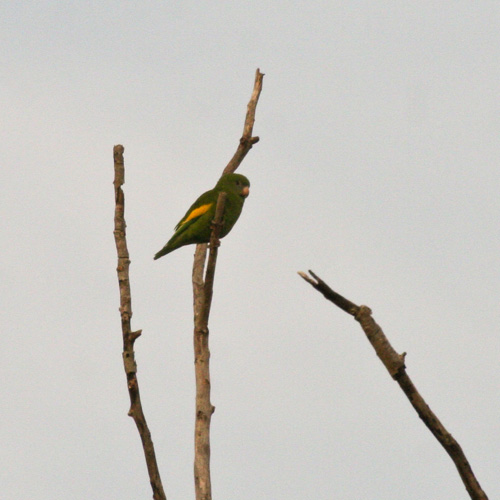In mid-January Barbara and I went to Miami to search for a La Sagra’s Flycatcher, a Western Spindalis and a Banaquit, which were being seen on Virginia Key or on Key Biscayne as reported on the North American Rare Bird Alert.
We found the La Sagra’s Flycatcher (my North American #712) without too much difficulty, along a stretch of road near the Sewage Treatment plant on Virginia Key.

A couple of days of searching failed to turn up the Western Spindalis or the Banaquit, although the former is still being seen on Virginia Key and the latter on Key Biscayne. We were among a significant group of birders who struck out during the days we were looking for these two rarities.
But the trip was not nearly the failure that a one-for-three result might imply. On several prior visits to Miami, I have looked for White-winged Parakeets, but never found them. On this trip, while again searching for White-winged Parakeets in north Miami, I spied two likely suspects perched in dead tree. At the time I thought they were Yellow-chevroned Parakeets, but after viewing Barbara’s photos, I am not sure of that. Maybe they are White-winged Parakeets.

I welcome any input from birders more familiar with the subtle distinctions between the two species who may chance to read this blog. Unfortunately, they did not fly so I never saw white (or lack thereof) on the wings.
Formerly conspecific with the White-winged Parakeet and together known as the Canary-winged Parakeet, the Yellow-chevroned Parakeet and the White-winged Parakeet were split into two separate species by the bird scientists a few years ago. The Yellow-chevroned Parakeets have not been recognized as “countable” by the American Birding Association (although they are now in fact more numerous than the White-wings).
Believing that I had not yet seen any White-winged Parakeets, on the afternoon before our return, following some tips from birders we met on the Keys, we drove to a car lot on a busy and noisy LeJeune Avenue, just south of the Miami Airport. The traffic was unbelievably loud, and was enhanced by very loud music broadcast at the car lot. The young men who worked at the car lot, however, knew just what we were looking for and helpfully pointed out the very tree where parakeets most often could be seen. They told us that the birds often flew back and forth between the car lot and Ocean Bank across LeJeune Avenue, where there were several large palm trees. We stuck it out at the car lot until dark, with no results. The next morning, however, we returned for a last ditch effort before going to the airport, and within minutes, several White-winged Parakeets (my North American list # 713) attracted us to the designated tree, where we were able to observe them briefly, before they flew across the street to the palm trees at the Ocean Bank “outdoor atrium”. We followed them, and Barbara was able to photograph them as they preened among the palm fronds.


The highlight of this trip, however, was not the birds, but the opportunity to join some first cousins once-removed, most of whom we had never met, at a family gathering and excellent dinner at one’s home in Coconut Grove. We had a great time with them.



